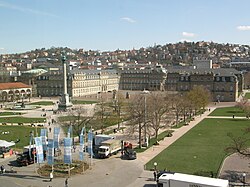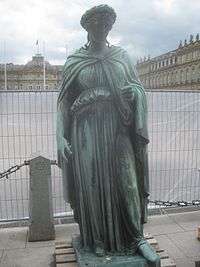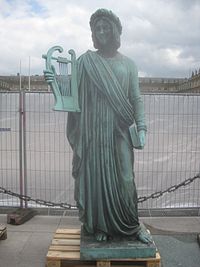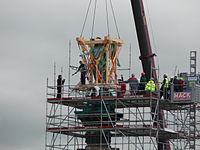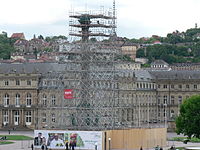Anniversary column
The anniversary column is a memorial that was erected on the occasion of the 25th anniversary of the government and the 60th birthday of King Wilhelm I of Württemberg from 1841 to 1846 on the Schloßplatz in Stuttgart .
The column consists of a 30-meter shaft of granite , the 5 meter high statue of the Roman goddess Concordia , four reliefs with historical scenes and four allegorical figures at the corners of the column base.
Flanked by two imposing fountains , aligned with the music pavilion and the Königsbau , the anniversary column in the center of Stuttgart's Schloßplatz , the “most beautiful square in the city”, dominates all the surrounding buildings thanks to its height and the impressive majesty of the goddess Concordia : the Marquardtbau , the Queen -Olga-Bau (behind: the St. Eberhard Church), the art building , the New Castle , the Old Castle , the Old Chancellery and the Art Museum .
pillar
View from the music pavilion to the anniversary column and the New Palace .
View from the New Palace to the anniversary column, behind it: Marquardtbau (left) and Königin-Olga-Bau .
View from the courtyard of the New Palace on the anniversary column and the royal building .
The square area around the anniversary column is separated from the rest of the palace square by iron chains reinforced with thorns, which are suspended from massive granite posts. The 30-meter-high anniversary column consists of ten granite blocks, each weighing 100 quintals , which were broken in a quarry in the Teufelsküche between Alpirsbach and Schenkenzell .
Two steps lead up to the expansive, square substructure of the column. The substructure consists of a wider base, which is decorated on four sides with relief depictions of historical events, and the high, cuboid column pedestal with the following dedication:
- "The Württemberg estates dedicate this monument to the most loyal friend of his people, King Wilhelm the Well-Beloved, to celebrate his 25th anniversary in government, October 30, 1841."
The transition between the base and the pedestal is formed by a three-tier structure, which has cube pedestals with allegorical figures at the four corners that symbolize the four stands.
The base plate ( plinth ) between the pedestal and the column shaft is decorated with bronze jewelry, which was cast in the Wasseralfingen ironworks under Paul Stotz : deer heads at the four corners (deer and lion are Württemberg's heraldic animals), between four oak garlands and a laurel wreath above. The round, smooth shaft ends with a bronze capital “which covers the shaft with the arbor of the olive tree. From this again 8 horns of plenty connected with laurel garlands rise. "
Concordia
The column is crowned by a 5 m high and 5 ton heavy, bronze sculpture of the goddess Concordia (Roman goddess of harmony) from 1863. It was created by the Württemberg court sculptor Ludwig von Hofer and cast by Ferdinand von Miller in the royal ore foundry in Munich .
The winged Concordia, wrapped in antique robes, stands on a ball, is surrounded by four lions (the deer and lion are the Wurttemberg heraldic animals) and wears a diadem with 64 battlements, which symbolize the 64 upper offices in Württemberg at the time . In her left hand the goddess holds a palm frond (symbol of peace) and in her outstretched right a laurel wreath (symbol of victory).
Reliefs
Four high reliefs by Theodor Wagner , No. 1 based on a design by Johann Michael Knapp and Theodor Wagner, No. 2–4 based on designs by the court painter Joseph Joachim von Schnizer (1792–1870), cast: Hüttenwerke Wasseralfingen under Paul Stotz (No. 1 , 2 and 4 and Wilhelm Pelargus (No. 3), dimensions unknown, bronze, 1846, on the sides of the pedestal .
Relief no. 1 opposite the New Palace represents the homage of both chambers of estates on the occasion of the 25th anniversary of the reign of King Wilhelm I of Württemberg in 1841, the other reliefs show "Battle scenes from the victorious campaigns of the Württembergians in the war of the allies against Napoleon I. [ 1814] under the leadership of Crown Prince Wilhelm as Field Marshal and Commander of the 4th Army Corps in France ”. In Kühne 1849 states: The reliefs "represent scenes from the life in front of the king, mostly battles after carver [so!] Famous paintings". These paintings may be in the holdings of one of the Württemberg museums or archives.
Inscription panels of the reliefs:
- Both chambers of estates paid homage on October 30, 1841.
- The storming of the city of Sens on February 11, 1814.
- The Battle of Fère-Champenoise on March 25, 1814.
- The Battle of Brienne on February 1, 1814.
Corner figures
|
|
Statues of female figures, allegories of the four estates by Theodor Wagner , cast: Royal ore foundry in Munich under Ferdinand von Miller , partially inscribed: “TH WAGNER inv. Et mod. STUTTGARDIA / FERD MILLER fudit MONACHII 1846. “, about one and a half life-size, bronze, 1846, corner figures on the pedestal of the column.
The four levels (attributes in brackets):
|
|
The photos were taken in 2013 when the figures were taken down from their pedestals for renovation and placed on the palace square.
history
On September 28, 1841 delegations from all upper offices and classes of Württemberg paid homage to King Wilhelm on his 25th anniversary in government with the parade of the Württemberg people . For this celebration, a 25 m high wooden column was built according to the plans of Johann Michael Knapp .
A few weeks later the king was proposed to erect a "column of iron" to commemorate the occasion. In December 1841, Karl Georg von Wächter , Tübingen University Chancellor and President of the Second Chamber , announced an artist competition for a monument. Knapp's revised design was awarded the contract. The foundation stone was laid on September 27, 1842 in the absence of King Wilhelm I and Crown Prince Karl (both were ill). Exactly one year after the foundation stone was laid, the jubilee column, which was still under construction, was ceremoniously unveiled on the king's 62nd birthday, and construction was completed three years later, in 1846. On June 27, 1863, a representation of the goddess Concordia , which can still be seen on the top of the column, was added.
Photograph by Hermann Brandseph , around 1893.
restoration
Restoration 2013
In May 2013 the anniversary pillar was scaffolded "from head to toe". The corner figures were taken down from their pedestals and placed on the castle square so that they could be worked on at ground level. All metal and natural stone parts should be checked for strength and corrosion by the restorers and then cleaned. The work should be completed before October 3, because the central celebrations for the Day of German Unity were to take place on Schloßplatz . However, the examination of the Concordia statue revealed that it could not be restored within the deadline due to corrosion damage. The restoration of the statue was therefore postponed to a later date.
Concordia restoration 2014/2015
The Concordia greets the attic figures of the New Palace as it flies past .
The Concordia was not melted down during World War II like so many other bronze works of art and survived the war almost unscathed (only a few bullet holes had to be closed). During the repair of the anniversary column in the summer of 2013, corrosion damage to the supporting iron parts inside the figure was found, which had to be repaired. In April / May 2014, the anniversary pillar was therefore scaffolded again. The scaffolding had a floor plan of 15 x 15 meters and reached to the top of the Concordia. On May 13, 2014, the statue together with the globe, the four lions and the capital were lowered to the ground with a crane so that they could be worked on at ground level. The almost one-year restoration work lasted until April 2015. On April 29th, the Concordia was moved back to its original place with a crane. At the beginning of May the scaffolding around the column was dismantled. The restoration cost the state of Baden-Württemberg around € 400,000.
Literary traces
The writer Isolde Kurz , who spent her early childhood in Stuttgart, recalls “an hour of unforgettable misery” in her book “From my youthful country”. The nanny had taken little Isolde with the little cart to the "so-called honor column" on Schlossplatz. Isolde believed she recognized her mother in one of the stone figures on the high substructure and "she screamed, frightened, to come down". When this did not move, she called “more and more anxious and pleading”: “Mamele, come on”.
literature
General
- Albert Eugen Adam; Karl Leibbrand : The anniversary column in Stuttgart. Stuttgart 1893.
- Max Bach : The anniversary column on the Schloßplatz . In: Stuttgarter Kunst 1794–1860, based on simultaneous reports, letters and memories, Stuttgart 1900, pp. 273–285.
- Karl Büchele: Stuttgart and its surroundings for locals and foreigners. Stuttgart 1858, pp. 113-116.
- Markus Dewald: The need for memory - The Stuttgart anniversary column. In: Schwäbische Heimat 57, 2006, pp. 401–404.
- Irene Ferchl: A childhood memory. Isolde Kurz. In: Narrated City: Stuttgart's literary places. Tübingen 2015, pp. 42–43.
- Sketches from Swabia . In: F. Gustav Kühne (editor): Europe: Chronicle of the educated world. Leipzig 1849, pp. 403-404 books.google.de .
- Morgenblatt for educated stalls / Art Journal Volume 22, 1841, No. 91 of 16 November 1841, p 379. Online: .
- Isolde Kurz : From my youth country. Stuttgart 1920, p 13, online: .
- Louis Mohl: The anniversary column in Stuttgart. A memorial dedicated to His Majesty King Wilhelm I by his loyal people. In addition to the latest ornamental surroundings of the same, Stuttgart 1862.
- Hermann-Alexander Müller: The museums and works of art in Germany. A handbook for travelers and repatriates, Leipzig 1858, page 62, online: .
- Patricia Peschel: Sculpture "Concordia" 1863 . In: The Stuttgart court sculptor Johann Ludwig von Hofer (1801–1887), work monograph, Stuttgart 2009, pp. 264–266.
- Friedemann Schmoll : The 25th anniversary of Wilhelm I's reign in 1841 and the Stuttgart anniversary column as a memorial to civil government. In: Eternal Nation. Studies on the culture of remembrance of the empire and individual state in the Württemberg monument cult of the 19th century, Tübingen 1995, pp. 86–97.
- Royal statistical-topographical Bureau (ed.): Description of the Stadtdirections-Bezirk Stuttgart, Stuttgart 1856, pp. 153–155 books.google.com .
- The anniversary column . In: Stuttgart. Guide through the city and its buildings. Festschrift for the sixth general assembly of the Association of German Architects and Engineers, Stuttgart [1884], p. 43.
- Gustav Wais: Municipal Lapidarium (Mörikestraße 24) . In: Stuttgarts Kunst- und Kulturdenkmale: 25 pictures with explanations of city history, building history and art history , Stuttgart [1954], pp. 26-27.
- Richard Zanker: Beloved old Stuttgart. Memories and Encounters, Stuttgart 1977, p. 25.
restoration
- Rolf-Dieter Blumer; Lisa Masen; Markus Numberger: On-site visit to the anniversary pillar without Concordia. About the restoration work on Stuttgart's Schlossplatz. In: monuments in Baden-Wuerttemberg, Vol 43, 2014, pp 206-207. Online: .
- Silvia Dittinger: Renovation on Schlossplatz. Makeover for the Roman goddess. In: Stuttgarter Nachrichten . No. 89 dated April 16, 2014 page 18, online: .
- Restoration. Jubilee column on Schlossplatz currently without a bronze figure. Press release from the Ministry of Finance and Economy Baden-Württemberg.
- David Rau: The goddess of unity is returning home. The scaffolding on Schlossplatz will be dismantled by May 10th at the latest. In: Stuttgarter Nachrichten . No. 99 of 30 April 2015 p 24, online: .
- Frank Rothfuß: From state candlelight to the baker's monument. The anniversary column on Schlossplatz is being renovated for 30,000 euros. In: Stuttgarter Nachrichten No. 117 of May 23, 2013, p. 22.
- State Office for the Preservation of Monuments Baden-Württemberg (ed.): "... simple and yet harmonious and beautiful ...". The Stuttgart anniversary column in the field of tension between state history, urban design and restoration , Ostfildern: Thorbecke 2020, ISBN 978-3-7995-1230-5 .
Web links
- Sculpture: Jubilee column on the website of the city of Stuttgart
- Jubilee column on statues - Hither & Thither .
- Panorama view of the Schloßplatz
- Stuttgart Concordia floats down , photo gallery on Stuttgarter-Nachrichten.de .
- Restoration of the anniversary column Stuttgart State Office for Monument Preservation Baden-Württemberg on YouTube
Footnotes
- ↑ Slogan of tourism advertising.
- ↑ #Zanker 1977 , page 25. - # Rothfuß 2013 : blocks weighing up to 1100 quintals.
- ↑ # Müller 1858 .
- ^ Adam 1893 , p. 5.
- ^ Adam 1893 , p. 8.
- ↑ This relief is usually wrongly interpreted as a constitutional oath or as a constitutional image (e.g. Bach 1900 , page 284; Dewald 2006 , page 403; Kühne 1849 , page 404). The so-called "constitutional image [...] does not represent the conclusion of the constitutional treaty of 1819 , which was indeed what one side wanted , but the homage to the assembly of the estates on the anniversary of the government in 1841" ( Adam 1893 , page 5).
- ↑ Dewald 2006 , page 403.
- ↑ Probable inscription on the missing inscription tablet. In the literature on the anniversary column, February 1, 1814 is also mentioned ( Adam 1893 , page 5; Dewald 2006 , page 403). The Wikipedia article Battle of Brienne states January 29, 1814 (see there for the reason).
- ^ Theodor Wagner design and model Stuttgart / Ferdinand Miller Guss Munich.
- ↑ Kühne 1849 .
- ↑ Missing on photos from 2011, still available on a photo from 2006.
- ↑ #Dewald 2006 .
- ↑ #Rau 2015 .
- ↑ #Short 1920 , printed in #Ferchl 2015 .
Coordinates: 48 ° 46 ′ 42.76 " N , 9 ° 10 ′ 47.68" E




